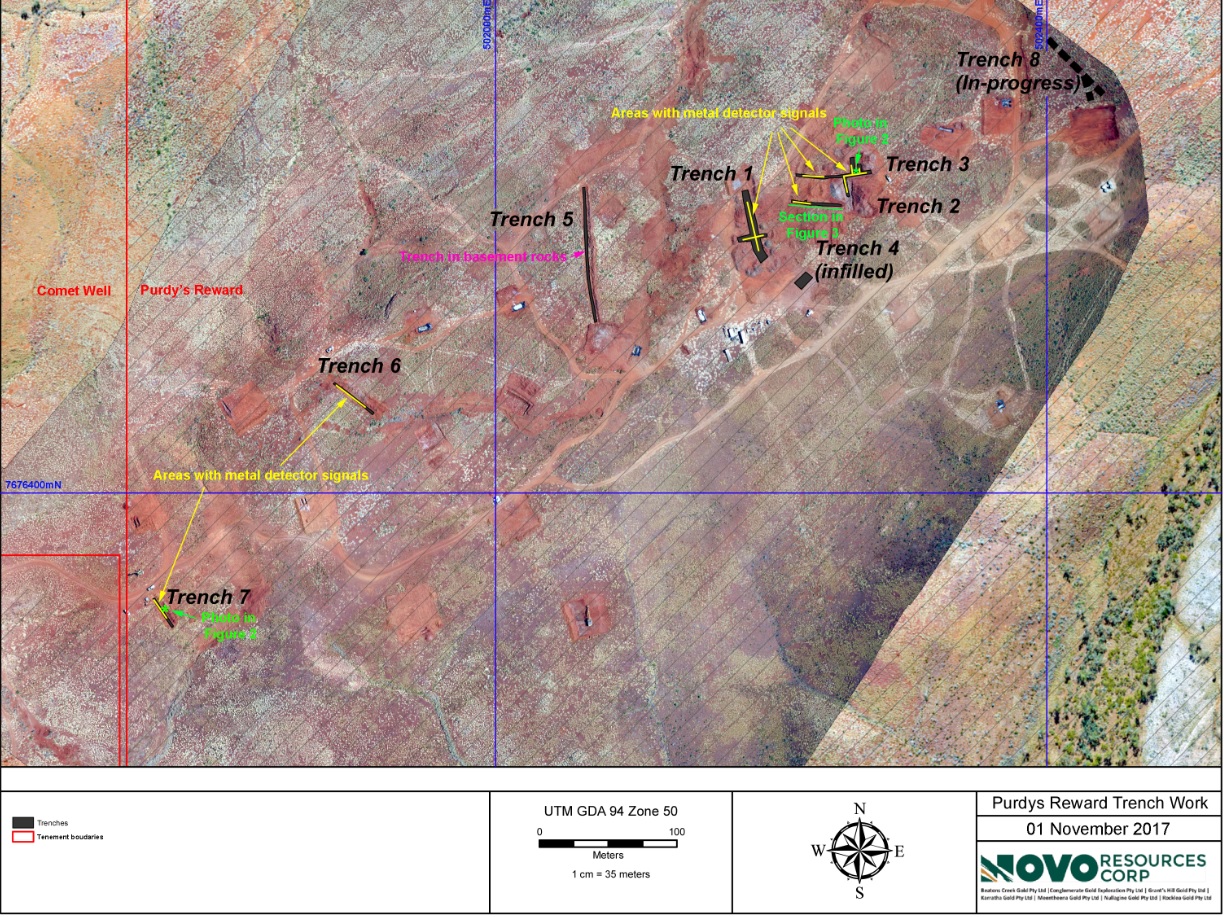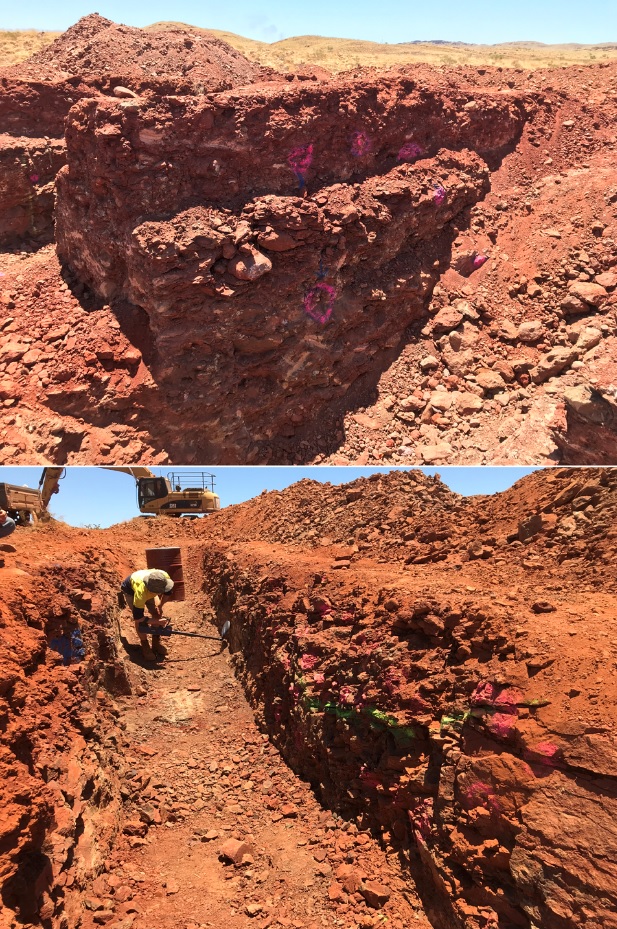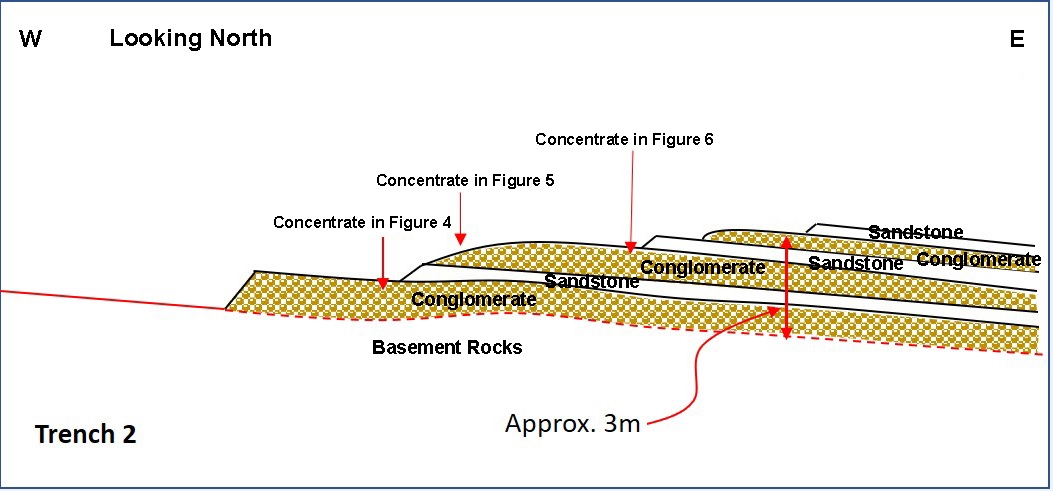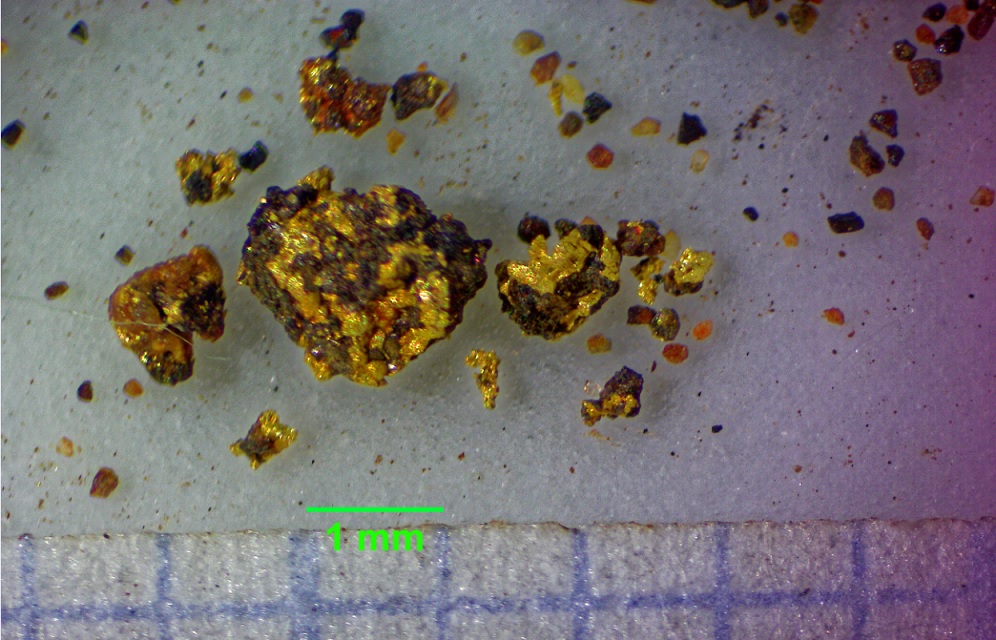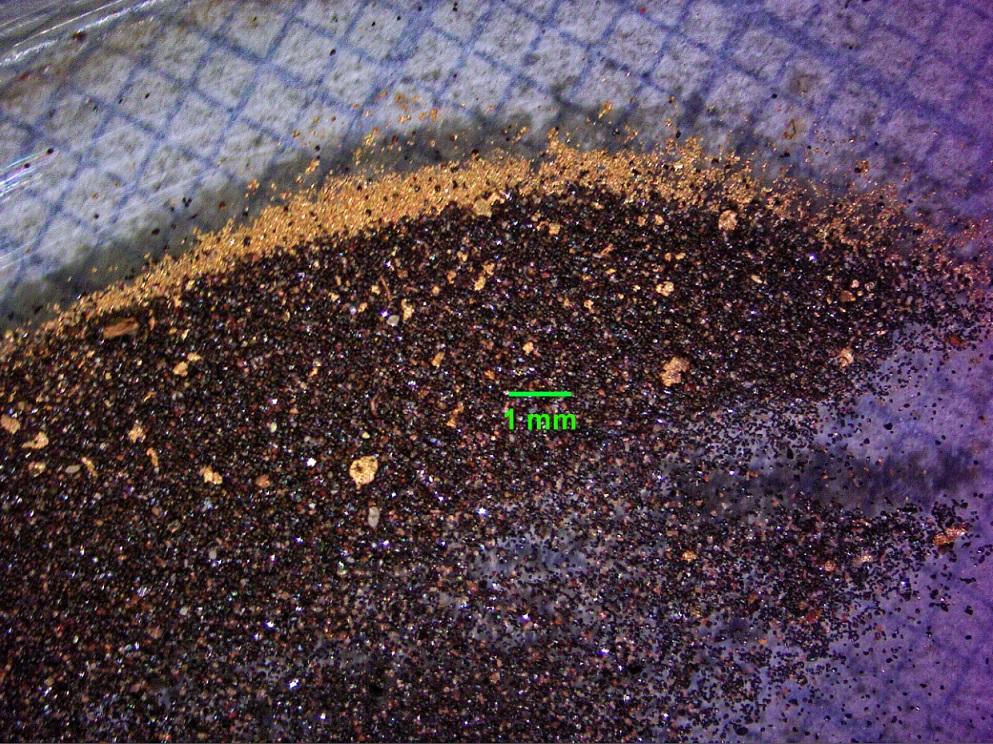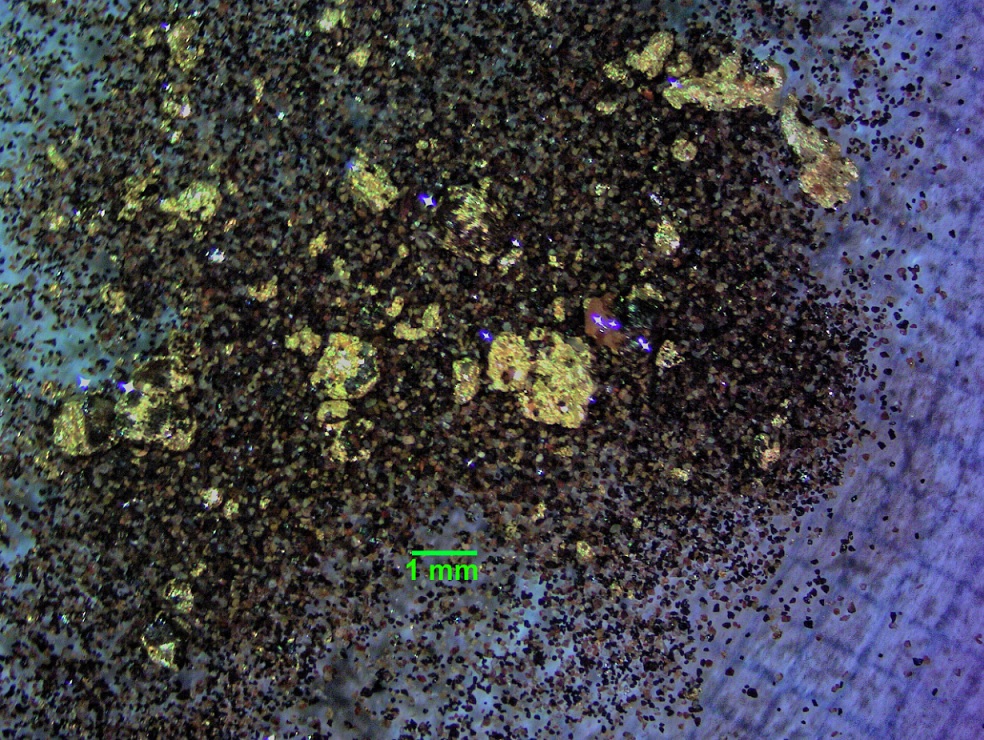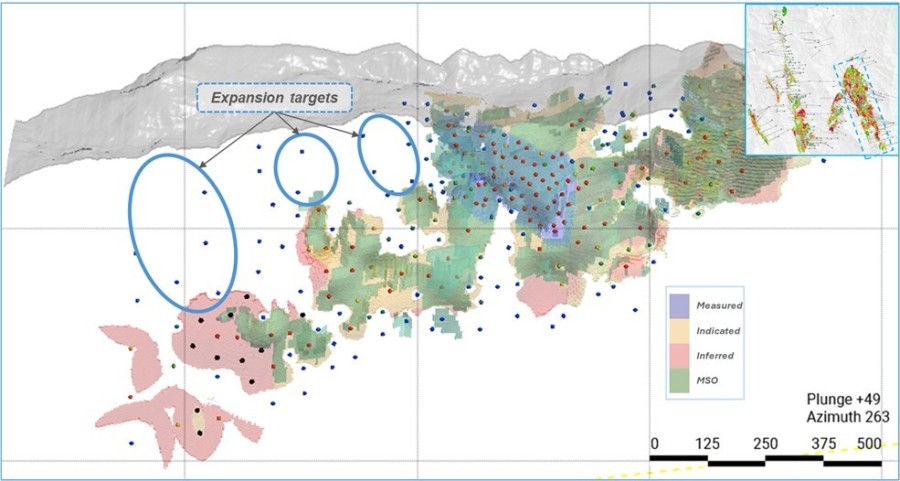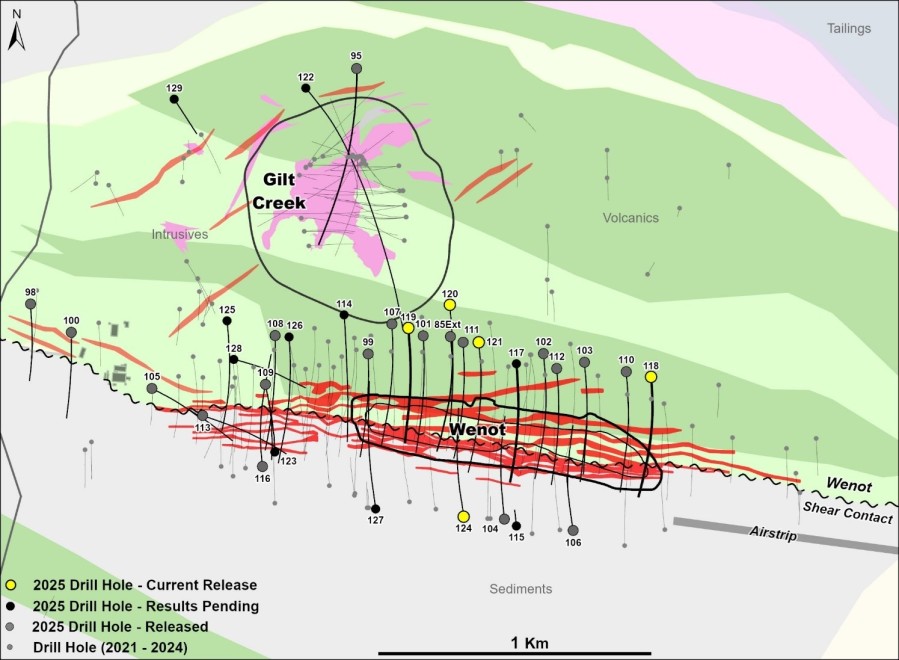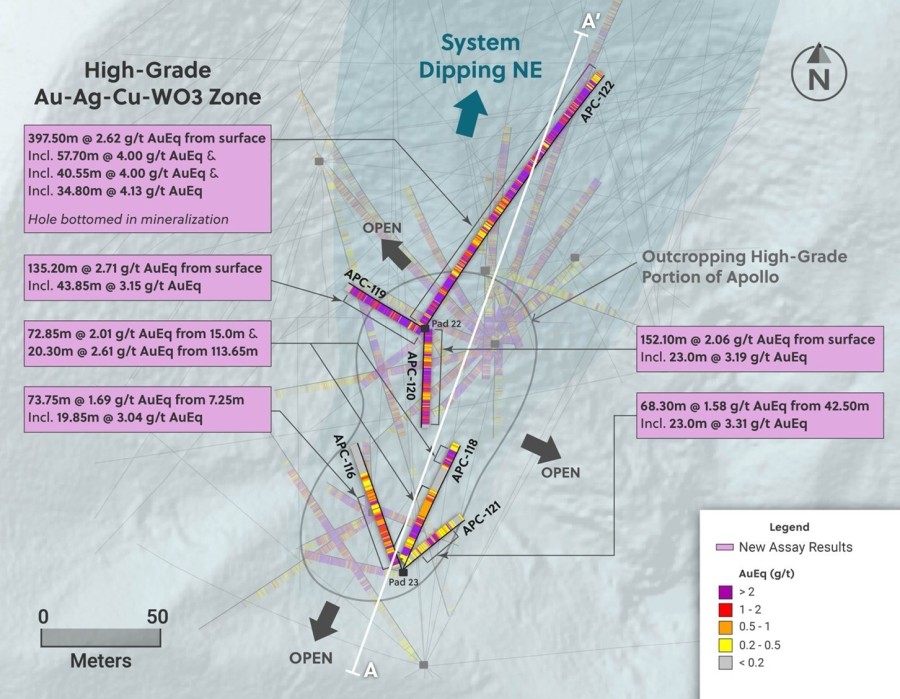VANCOUVER, British Columbia, Nov. 02, 2017 (GLOBE NEWSWIRE) -- Novo Resources Corp. (“Novo” or the “Company”) (TSX-V:NVO) (OTCQX:NSRPF) is pleased to provide an update on exploration activities at the Purdy’s Reward tenement, a farm-in and joint venture Novo has with ASX-listed Artemis Resources Limited and part of Novo’s greater Karratha gold project, Western Australia.
As core drilling has progressed to areas further down dip (please refer to the Company’s news release dated October 17, 2017 for further information), Novo has commenced a program of systematic trenching in areas of outcropping and sub cropping gold-bearing conglomerates. Novo has opened seven trenches with an eighth underway (please see Figure 1 below) and many more planned. Trenches are being dug with a 40-tonne excavator and range in depth from one to three meters. All trenches have encountered targeted conglomerate units with the exception of trench 5 which encountered older basement rocks.
Upon opening, the geology of each trench is mapped and marked in preparation for sampling (please see Figure 2 below). Select walls and floors are swept with a metal detector, and strikes are marked with paint and geo-referenced with a differential GPS system. Sampling is generally conducted in areas that have not been swept with a metal detector so as to avoid sampling bias. Samples are collected in sealable steel drums. Novo has hired full-time, independent scrutineers to oversee all sampling activities and seal sample drums.
As observed in recent core holes, conglomerate horizons are interbedded with thin sandstone layers (please see Figure 3 below). Beds dip at shallow angles, generally less than five degrees, southeast. The lowermost conglomerate unit rests unconformably atop older basement rocks including gabbro, metabasalt and metasedimentary rocks. Up to eight discrete conglomerate beds are evident with some displaying characteristics of a fluvial (river) origin and others displaying traits suggesting reworking in a shallow marine environment. Novo considers the depositional environment to be near-shore with sea level rising and falling over time, an environment suited for reworking of gravels and concentrating gold.
Gold mineralization at Purdy’s is generally coarse and nuggety. A bulk sample collected in July 2017 was subjected for metallurgical test work and was found to contain appreciable fine grained gold (please refer to the Company’s news release dated August 8, 2017 for further details). To further investigate the presence of fine-grained gold, Novo personnel collected, sieved and panned several grab samples from recently opened trenches. As an example, three grab samples from the lower two conglomerate units exposed in trench 2 yielded significant fine-grained gold (please see Figures 4, 5 and 6 below). While it is important to note that these samples do not provide quantitative gold analyses, they serve to confirm a component of fine-grained gold is present in the system and results to date have not provided Novo with clarity. A deportment study is currently underway that should help provide such understanding.
“We are pleased to see this level of fine gold and are excited to commence our trenching program in earnest at Purdy’s Reward,” commented Dr. Quinton Hennigh, President, Chairman and Director of Novo Resources Corp. “Information gathered from these trenches is already proving invaluable. The geology is telling us we are in a favorable geologic environment. We have further indications of a significant fine-grained gold component in this system, something that could prove to be very important as we evaluate this project. Bulk samples extracted from trenches will prove critical to helping establish gold grades. In short, this is our first close-up view of this deposit, and we are quite excited by what we see.”
Karratha Gold Project
Gold mineralization at Karratha is hosted by a sequence of conglomerate beds, fossil gravel horizons, ranging from a few meters to approximately 20 meters thick comprising the base of a much thicker package of sedimentary and volcanic rocks called the Fortescue Group. Rocks of the Fortescue Group were deposited between 2.78 and 2.63 years ago upon 3.0-3.7 billion year old igneous and metamorphic rocks that make up the Pilbara craton, an ancient piece of Earth’s crust.
Over the past year, local metal detectorists have excavated gold nuggets originating from weathered conglomerate along an eight-kilometer, southwest-trending corridor between the Purdy’s Reward prospect (please refer to the Company’s news releases dated May 26 and August 15, 2017) and Comet Well (please refer to the Company’s news releases dated April 11, June 26 and August 3, 2017). These gold-bearing conglomerates dip gently southeastward under cover at angles of between 2 and 20 degrees. The Company secured 100% control over approximately 7,000 sq km in areas along strike and down dip from Purdy’s Reward and Comet Well through aggressive staking earlier this year. Novo believes that these gold-bearing conglomerates may underlie significant areas within the greater Fortescue basin.
In its news release dated July 12, 2017, Novo discussed discovery of gold nuggets in a bulk sample collected from a trench at the Purdy’s Reward prospect. Metallurgical test work conducted on this sample was discussed in the Company’s news release issued August 8, 2017. The weighted average grade of two splits of this bulk sample was 67.08 gpt Au. Approximately 82% of the gold in this sample was determined to be coarse, mainly nuggets displaying several interesting characteristics. These are commonly flattened with rounded edges giving them an appearance similar to watermelon seeds. Most are coarse, +2 mm and are not attached to quartz or other minerals. Gold is of high purity, +96%, much higher than the gold content of nuggets derived from basement-hosted lode gold deposits from the Pilbara region that commonly display purities of 70-90%. Nuggets display crenulated surfaces thought derived from burial and compaction within a sandy matrix.
In addition to coarse gold, this metallurgical test confirmed a significant fine-grained gold component is present in these conglomerates. Such fine gold, if it is indeed disseminated throughout the conglomerates, could prove important to help evaluate grade and continuity of this deposit.
Dr. Quinton Hennigh, the Company’s, President and Chairman and a Qualified Person as defined by National Instrument 43-101, has approved the technical contents of this news release.
About Novo Resources Corp.
Novo’s focus is to explore and develop gold projects in the Pilbara region of Western Australia, and Novo has built up a significant land package covering approximately 12,000 sq km. Novo also controls a 100% interest in approximately 2 sq km covering much of the Tuscarora Au-Ag vein district, Nevada.


